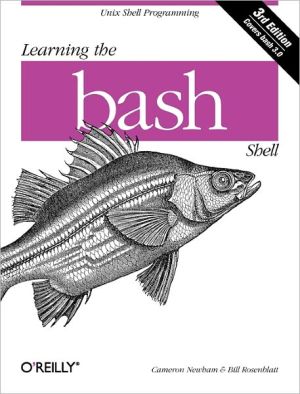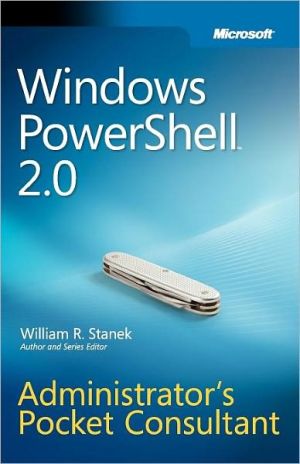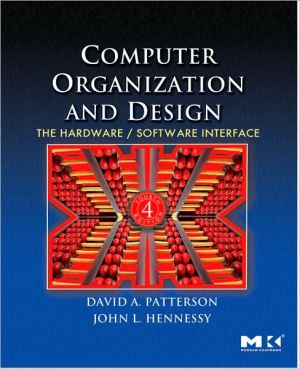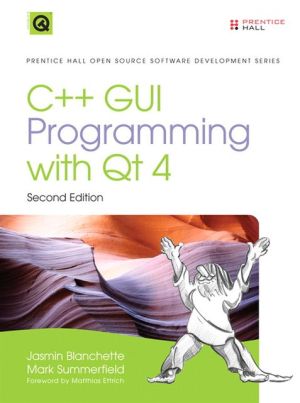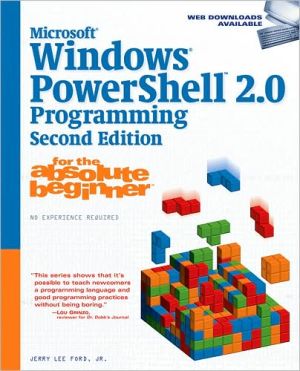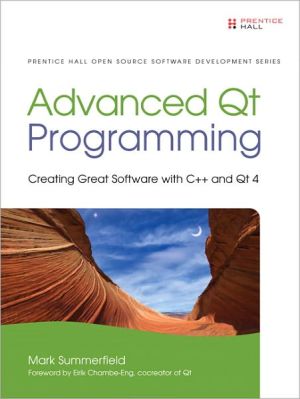Learning the Bash Shell
O'Reilly's bestselling book on Linux's bash shell is at it again. Now that Linux is an established player both as a server and on the desktop Learning the bash Shell has been updated and refreshed to account for all the latest changes. Indeed, this third edition serves as the most valuable guide yet to the bash shell.\ As any good programmer knows, the first thing users of the Linux operating system come face to face with is the shell the UNIX term for a user interface to the system. In other...
Search in google:
Learning the bash Shell is the definitive guide to bash, the Free Software Foundation's "Bourne Again Shell". It's a freely available replacement for the popular UNIX Bourne shell. It is also the shell of choice for Linux users around the world. You'll find this guide valuable whether you're interested in bash as a user interface or for its powerful programming capabilities. It will teach you how to use bash's advanced command-line features, like command history, command-line editing, and command completion. Learning the bash Shell also introduces shell programming, a skill no UNIX or Linux user should be without. The book demonstrates what you can do with bash's programming features. You'll learn about flow control, signal handling, and command-line processing and I/O. There is also a chapter on debugging your bash programs. Finally, Learning the bash Shell shows you how to get bash, install it, configure it, and customize it. It also gives advice to system administrators managing bash for their user community. Booknews A guide to bash, a default shell, or command interpreter, for Linux, a free UNIX-like operating system for PCs. Comprehensively covers bash's features for both interactive use and programming. Annotation c. Book News, Inc., Portland, OR (booknews.com)
\ From Chapter 1: bash Basics\ \ ...Pipelines\ \ It is also possible to redirect the output of a command into the standard input of another command instead of a file. The construct that does this is called the pipe, notated as \|. A command line that includes two or more commands connected with pipes is called a pipeline.\ \ Pipes are very often used with the more command, which works just like cat except that it prints its output screen by screen, pausing for the user to type SPACE (next screen), RETURN (next line), or other commands. If you're in a directory with a large number of files and you want to see details about them, Is -1 \| more will give you a detailed listing a screen at a time.\ \ Pipelines can get very complex, and they can also be combined with other I/O directors. To see a sorted listing of the file cheshire a screen at a time, type sort < cheshire \| more. To print it instead of viewing it on your terminal, type sort < cheshire \| lp.\ \ Here's a more complicated example. The file /etc/passwd stores information about users' accounts on a UNIX system. Each line in the file contains a user's login name, user ID number, encrypted password, home directory, login shell, and other information. The first field of each line is the login name; fields are separated by colons (:). A sample line might look like this:\ \ cam:LM1c7GhNesD4GhF3iEHrHrH4FeCKB/:501:100:Cameron Newham:/home/cam:/bin/bash\ \ To get a sorted listing of all users on the system, type:\ \ $ cut -d: -f1 < /etc/passwd \| sort\ \ (Actually, you can omit the <, since cut accepts input filenamearguments.) The cut command extracts the first field (-f1), where fields are separated by colons (-d:), from the input. The entire pipeline will print a list that looks like this:\ \ adm\ bin\ cam\ daemon\ davidgc\ ftp\ games\ gonzo\ ...\ \ If you want to send the list directly to the printer (instead of your screen), you can extend the pipeline like this:\ \ $ cut -d: -f1 < /etc/passwd \| sort \| lp\ \ Now you should see how I/O directors and pipelines support the UNIX building block philosophy. The notation is extremely terse and powerful. Just as important, the pipe concept eliminates the need for messy temporary files to store command output before it is fed into other commands.\ \ For example, do the same sort of thing as the above command line on other operating systems (assuming that equivalent utilities are available...), you need three commands. On DEC's VAX/VMS system, they might look like this:\ \ $ cur [etc]passwd /d=":" /f=1 /out=temp1\ $ sort temp1 /out=temp2\ $ print temp2\ $ delete temp1 temp2\ \ After sufficient practice, you will find yourself routinely typing in powerful command pipelines that do in one line what it would take several commands (and temporary files) in other operating systems to accomplish.\ \ Background Jobs\ \ Pipes are actually a special case of a more general feature: doing more than one thing at a time. This is a capability that many other commercial operating systems don't have, because of the rigid limits that they tend to impose upon users. UNIX, on the other hand, was developed in a research lab and meant for internal use, so it does relatively little to impose limits on the resources available to users on a computer--as usual, leaning towards uncluttered simplicity rather than overcomplexity.\ \ "Doing more than one thing at a time" means running more than one program at the same time. You do this when you invoke a pipeline; you can also do it by logging on to a UNIX system as many times simultaneously as you wish. (If you try that on an IBM's VM/CMS system, for example, you will get an obnoxious "already logged in" message.)\ \ The shell also lets you run more than one command at a time during a single login session. Normally, when you type a command and hit RETURN, the shell will let the command have control of your terminal until it is done; you can't type in further commands until the first one is done. But if you want to run a command that does not require user input and you want to do other things while the command is running, put an ampersand (&) after the command.\ \ This is called running the command in the background, and a command that runs in this way is called a background job; by contrast, a job run the normal way is called a foreground job. When you start a background job, you get your shell prompt back immediately, enabling you to enter other commands.\ \ The most obvious use for background jobs is programs that take a long time to run, such as sort or uncompress on large files. For example, assume you just got an enormous compressed file loaded into your directory from magnetic tape.* Let's say the file is gcc.tar.z, which is a compressed archive file that contains well over 10 MB of source code files.\ \ Type uncompress gcc.tar & (you can omit the .Z), and the system will start a job in the background that uncompresses the data "in place" and ends up with the file gcc.tar. Right after you type the command, you will see a line like this:\ \ [1] 175\ \ followed by your shell prompt, meaning that you can enter other commands. Those numbers give you ways of referring to your background job; Chapter 8, explains them in detail.\ \ You can check on background jobs with the command jobs. For each background job, jobs prints a line similar to the above but with an indication of the job's status:\ \ [1]+ Running uncompress gcc.tar &\ \ When the job finishes, you will see a message like this right before your shell prompt:\ \ [1]+ Done uncompress gcc.tar\ \ The message changes if your background job terminated with an error; again, see Chapter 8 for details...
Preface Chapter 1. bash Basics Chapter 2. Command-Line Editing Chapter 3. Customizing Your Environment Chapter 4. Basic Shell Programming Chapter 5. Flow Control Chapter 6. Command-Line Options and Typed Variables Chapter 7. Input/Output and Command-Line Processing Chapter 8. Process Handling Chapter 9. Debugging Shell Programs Chapter 10. bash Administration Chapter 11. bash for Your System Appendix A. Related Shells Appendix B. Reference Lists Appendix C. Loadable Built-Ins Appendix D. Syntax Appendix E. Obtaining Sample Programs Index
\ From Barnes & Noble\ \ Fatbrain Review\ This is the definitive guide to the "Bourne Again Shell" (bash). Bash is a modern general purpose UNIX and LINUX shell that incorporates elements of the C and Korn shells. It covers the new commands and features of bash version 2.0, and emphasizes POSIX compliance in POSIX 2.0 mode. This publication is designed for those who have just starting shell programming. The authors guide you from bash installation and command line editing through customization, flow control, process handling and debugging. Along the way, you learn about shell scripts, I/O and command line processing, positional parameters, properties and shell administration. The new features for bash v2.0 are command line editing, bindings, arrays, dynamic loading and integrated programming.\ \ \ \ \ BooknewsA guide to bash, a default shell, or command interpreter, for Linux, a free UNIX-like operating system for PCs. Comprehensively covers bash's features for both interactive use and programming. Annotation c. Book News, Inc., Portland, OR (booknews.com)\ \
